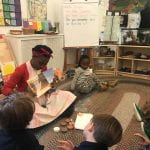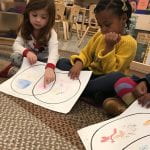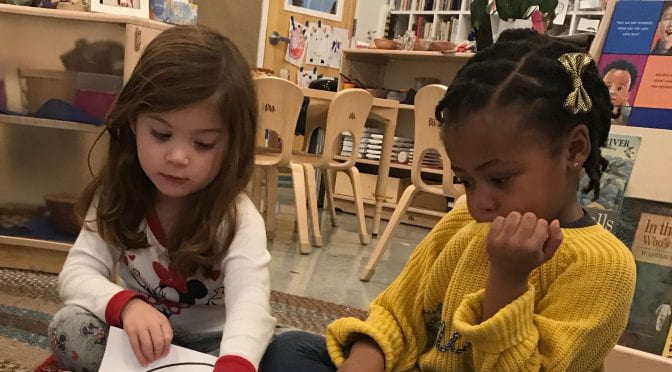Essential Questions:
- Who am I and who are the people in my life?
- How does learning about the world around me help me learn more about myself and others?
- For example, how does learning about diversity in nature lend itself to conversations about human diversity?
Overview
How do you get four year olds to slow down and pay attention? In our preschool classroom the answer was to be intentional, get out in nature, and make sure to have lots of fun.
In the beginning of the year, children were asked to slow down and pay attention to the many trees in our school neighborhood. We took time to walk around the block, visit and sketch our “class tree” and notice the other trees in the neighborhood. Instead of just calling it a “tree,” we got specific and called them by their type, maple or a sycamore for example. We felt it was very important to name the trees and introduce the words tree diversity. This was intentional as we would eventually delve more into our own identity and diversity. We read lots of books and made sure that we made an effort to point out how trees can look the same but are actually quite different.
 Children started to slow down and ask questions, “What is this one?” “The leaves are pointy.” “This bark is rough not smooth.” Thinking about trees in this way gave us a great starting point to thinking about ourselves and how people can be both the same and different. This was a great setup to look more in-depth at the parts of trees and what makes each type of tree different and unique. We connected the trees to ourselves as we began to explore what makes us, us. Our skin color, hair, hair texture, our family, the things we like and dislike. At this point we introduced our classroom working definition of identity: who we are, what we are made of, and our story.
Children started to slow down and ask questions, “What is this one?” “The leaves are pointy.” “This bark is rough not smooth.” Thinking about trees in this way gave us a great starting point to thinking about ourselves and how people can be both the same and different. This was a great setup to look more in-depth at the parts of trees and what makes each type of tree different and unique. We connected the trees to ourselves as we began to explore what makes us, us. Our skin color, hair, hair texture, our family, the things we like and dislike. At this point we introduced our classroom working definition of identity: who we are, what we are made of, and our story.
Tammy’s Reflective Practice
Teachers continued to provide experiences where children are asked to challenge themselves and their thinking about self and others. I worked to think deeply about the work being done in the classroom and how to engage children in a meaningful way. In one such experience, children were asked to work in partnerships using a venn diagram to share things that are a part of their identity and to explore what they have in common or what is different. Children eagerly set to work to share ideas. I wanted to intentionally provide opportunities for children to challenge their thinking about their classmates and this felt good, but how could we go even deeper?
As we approached the Dr. Martin Luther King, Jr. holiday it was clear children were making connections with classmates and curious about the work of the Changemakers we have been studying all year. The classroom is often abuzz of talk about Changemakers and kindness – the learning is visible. Children were overheard practicing restorative justice or saying, “Gandhi would not like that” or “Ruby Bridges would think that is not ok”. All of the explicit and implicit learning experiences seemed to be paying off! I was really excited about the pace and the flow of the work. I felt confident that the foundation was being laid for even deeper conversations in the coming months and years. And then we hit a speed bump.
The speed bump came in the form of frequent visitors to our classroom. Each day various members of the cafeteria staff deliver food to the classroom, one speaking only Spanish and two speaking to us only in English. When children were reminded to say thank you to the cafeteria staff the children would answer consistently, in Spanish regardless of what language was spoken to us. This was concerning and the hmmm moment. Why would they answer these visitors in Spanish and no other visitors to our class? I asked them just this, “What about the cafeteria visitors makes you speak Spanish to them when they spoke English to us?” They offered thoughts such as, “Because they work in the cafeteria” or “Because they look like they speak Spanish.” I then asked, “What about people who work in the cafeteria makes you think they speak Spanish?” It was clear that there was something else at work here and the work we were doing was just one aspect of what was needed.
 There were pernicious elements at play that reach beyond conscious thinking. The children were making an assumption and demonstrating a bias. Children classify people very early and it was clear that they were using erroneous thinking about their perceived understanding of people based on their job. A true anti-bias curriculum, one that looks closer and tries to help unlearn errors in thinking, was what I was after. It was time to explore bias, assumptions, and stereotypes. Using the Teaching Tolerance Anti-Bias Framework I decided to focus on 2 anchor standards in the Justice Domain; 11) Students will recognize stereotypes and relate to people as individuals rather than representatives of groups and 13) Students will analyze the harmful impact of bias and injustice on the world, historically and today.
There were pernicious elements at play that reach beyond conscious thinking. The children were making an assumption and demonstrating a bias. Children classify people very early and it was clear that they were using erroneous thinking about their perceived understanding of people based on their job. A true anti-bias curriculum, one that looks closer and tries to help unlearn errors in thinking, was what I was after. It was time to explore bias, assumptions, and stereotypes. Using the Teaching Tolerance Anti-Bias Framework I decided to focus on 2 anchor standards in the Justice Domain; 11) Students will recognize stereotypes and relate to people as individuals rather than representatives of groups and 13) Students will analyze the harmful impact of bias and injustice on the world, historically and today.
Our work with fairy tale representations of the Big Bad Wolf will help to address these standards. I will continue to stop strategically and ask what is happening, what they notice about the people in the pictures? Stopping and pausing needs to happen to further these conversations. It is the work in the fours to help children explore concepts of identity and justice in an experiential way. Showing children that these things are important and to help them unlearn bias and turn toward anti-racism and racial justice.


It strikes me that the simplicity that rests in the notion of “slowing down” and noticing is so often very hard. Helping to build this skill with the fours seems so essential. It is truly a habit that is needed in a world that seems always to be moving faster. And the “shortcuts” that we take are often ones too easily grounded in unconscious bias. Helping learners to interrogate the seemingly simple choices that we make will, one hopes, help them to develop the reflective habits that are so essential to the self-work that uncovering bias requires. It will be interesting to see what levels of complexity (in what is said, implied and omitted) that they can tease out from the fairy tales you explore together.
This really intensifies some of the things you and Tori presented on during the professional day. “Un-learning errors in thinking” really resonated with me. These biases are so much a part of our thought processes so early on, I’m always in search of a book that “shocks” readers with alternatives to their assumptions. It helps a person get through the day knowing that such intentional, thoughtful and thought-provoking work is going on in the classrooms, where the heart of these children’s education is taking place.